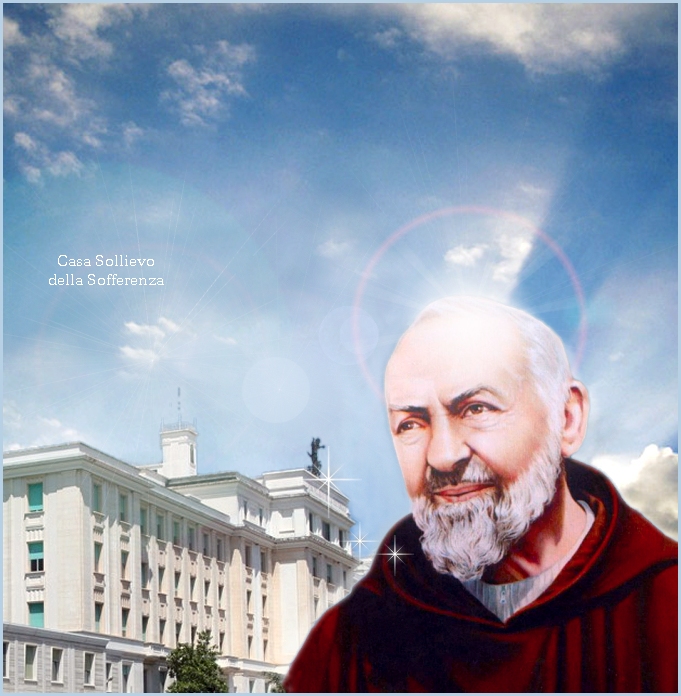   Casa Sollievo della Sofferenza  The charity of St. Pio of Pietrelcina was above all his works, which is exemplified by the House for the Relief of the Suffering or "Casa Sollievo della Sofferenza," the magnificent hospital that Padre Pio built at San Giovanni Rotondo in the Province of Foggia, for the sick of Monte Gargano where no hospital existed, as well as for the suffering people of all Italy who may come to see him. [Who is Padre Pio?, p. 43.] The plan for Casa Sollievo took on shape on an evening early in January, 1940, when Padre Pio said to three of his friends, spiritual sons whom he had salvaged from spiritual shipwreck. The Saint had been discoursing on the suffering of the human race because of sin: "One single act of love on the part of man, one single act of charity is so great in God's eyes, that he could not repay it with even with the immense gift of the entire Creation! Love is the spark of God personified in the Holy Spirit!" [Padre Pio, the Stigmatist, Fr. Charles M. Carty, p. 297.] And then, suddenly taking from his pocket a small gold coin that he had received as a gift, he said "I wish to make the first contribution toward the building of a hospital." [Who is Padre Pio?, p. 43.] At first the three others objected because Italy's economy was in dire straits and because the location that the Padre wanted was in the rocky terrain of Gargano. But, he had spoken and his word could stand alone, so they relented since they knew it was for the relief of the poor and the sick. "There was a practical side to Padre Pio, which perceived the need to tend to physical ailments of the people. This I was, of course, not without its spiritual counterpart, which was, as always, to lead souls to our Lord. In comforting the afflicted it was necessary to provide a clean, wholesome, dignified atmosphere for all without discrimination between the rich and the poor. Upon discharge each patient would receive a receipt regardless of his ability to pay the bill for services rendered." [From the Housetops, Vol. XXXIX, No. 2, Serial No, 78, p. 18.] Immediately numerous small contributions started coming. Interestingly very same evening two lire were given by a blind young man. Then other little offerings of one, two and five lire. Lists of subscribers came in, even from some Military Hospitals, sums of thirty or forty lire, made of small contributions of twenty and thirty centimes. Then came a large donation of one million, three hundred thousand lire from a friend living abroad. The sum of the small contributions added up to eighty thousand lire, all in prewar currency. The three friends, who saw the devastating effects of the war on their country, grew concerned about the Hospital. Padre Pio advised them to invest the money they had in purchasing of a landed estate. In the little Capuchin Church of San Giovanni Rotondo the Saint poured out his heart and soul to God, for he had taken upon himself the sufferings of all and unceasingly implored Him to grant relief. Our Lady of Divine Grace, in her picture which hangs over main altar, looked down upon her son as if the tears of all mankind awash in suffering seemed to stream down from her soulful eyes. VIEW A VARIATION OF THE IMAGE OF OUR LADY OF DIVINE GRACE Construction commenced on May 19, 1947; the traditional ribbon cutting ceremony took place on May 5, 1956, after Mass, which was said on the steps to the front entranceway. "High above, atop the building, three hundred flags representing countries around the globe, fluttered in display of their colors. There was a crowd of about fifteen thousand, including dignitaries . . . His Holiness Pope Pius XII sent his Apostolic Blessing, with a message referring to the Casa Sollievo della Sofferenza as 'a work inspired by a pro found sense of charity'. His Eminence Cardinal Lecaro and Padre Pio together cut the ribbon giving way to the culmination of the fruits of much labor for the sake of charity." [From the Housetops, Vol. XXXIX, No. 2, Serial No, 78, p. 19.] The staff was selected based on their devotion to prayer and knowledge. The hospital is immense, providing the most modern of equipment, including a department of radiology and therapy which is considered to among the best in the world. Signor Lupi of Pescara was the architect and engineer, and is well known for his architectural achievements. The director of the Casa di Sollievo was the late Dr. Guglielo Sanguinetti, once also an atheist, who left his practice and his clinic in Florence to support the work of the Padre. A very big statue of St. Francis of Assisi with outstretched arms dominates the hospital; it is twenty feet high and was made by a native artist who like Cimabue and Andrea del Sarto, was once a shepherd and modeled little figures out of clay as he watched his sheep. His name was Antonio Berti. [Who is Padre Pio?, p. 43.] We regret that we do not have a picture of the statue. There is even a helicopter pad atop the hospital for transporting long-distance patients. At the time of its completion the building housed 350 patient beds. Pontiffs have made pilgrimages there and Italy once issued a postage stamp in honor of the Padre and his hospital. of charity. Patients, when released pay as they can afford, or not at all, if they are in need. Servite Domino in laetitia!  E-MAIL E-MAIL HOME------------------------------------------------------------SAINTS www.catholictradition.org/Padre-Pio/padre-pio11d.htm |